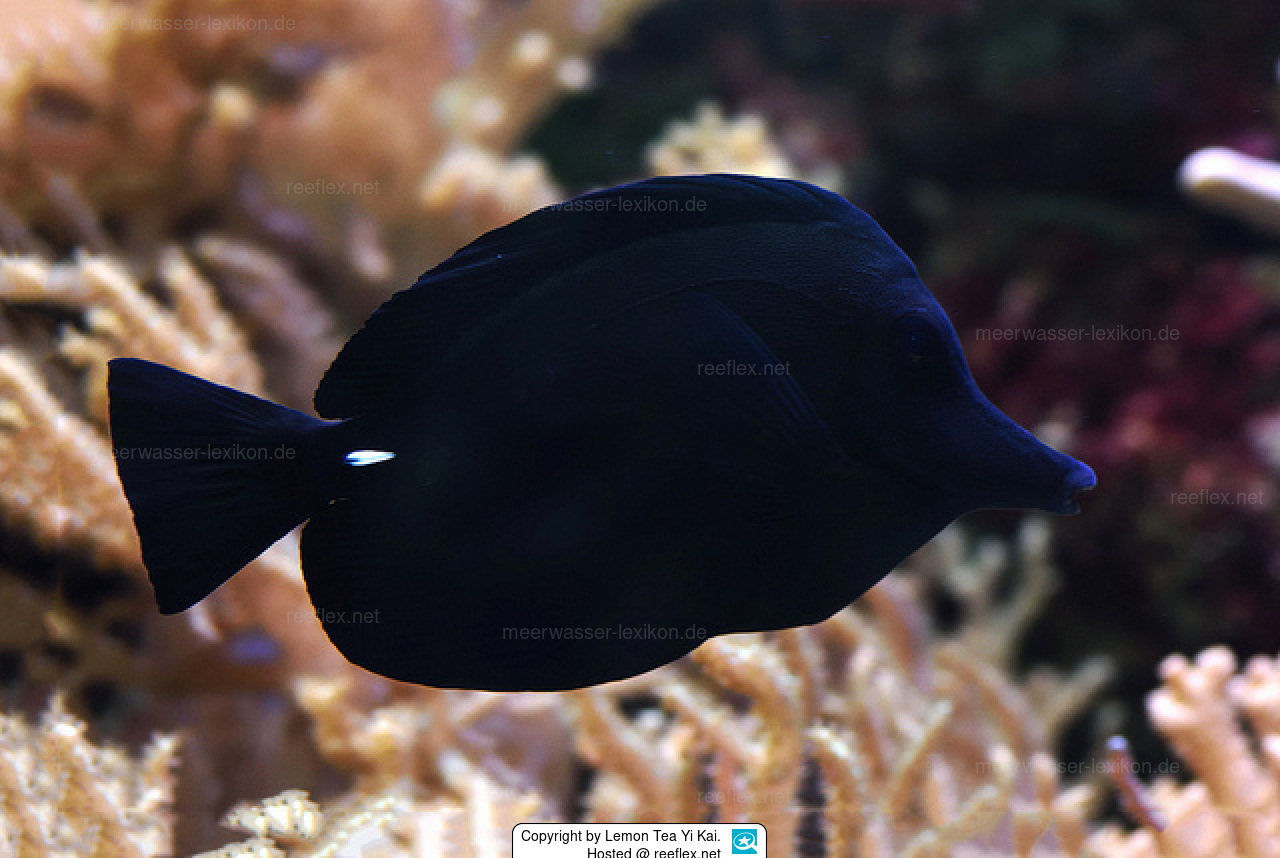Info
(Günther, 1875)
In comparison with Zebrasoma flavescens, Zebrasoma rostratum is rather rare in the marine aquaristic trade and a lot more expensive which is probably due to its limited natural range.
Its common name Longnose Sailfin tang alludes to the exceptionally long snout of Zebrasoma rostratum. Though all Zebrasoma species have a protruded snout, that of the Longnose Sailfin Tang comprises in fact about 30 % of its body length.
The colouring of its body may range from dark brown to a jet black, the Longnose Sailfin tang, however, will only show its full colours when feeling comfortably, otherwise it will turn into a dull greyish.
As a relatively peaceful species it will get along well with a wide range of fish species and – provided you have a very large tank and well-structured reef setup-– may be kept together with other surgeonfish as long as there are no similarities, that means, a combination with e.g. a Naso tang, Yellow tang or Hippo tang may work well, but you should avoid housing two Longnose Sailfin tangs in the same tank.
Since all surgeonfish species can be territorial, it is best to introduce several species together rather than adding a new one later on.
Once acclimatized, it is rather robust and may delight its owner many years.
Synonym:
Acanthurus rostratus Günther, 1875
Classification: Biota > Animalia (Kingdom) > Chordata (Phylum) > Vertebrata (Subphylum) > Gnathostomata (Superclass) > Pisces (Superclass) > Actinopterygii (Class) > Perciformes (Order) > Acanthuridae (Family) > Acanthurinae (Subfamily) > Zebrasoma (Genus)
The surgeonfishes (Acanthuridae), popular in marine aquaristics, are also called surgeonfishes.
They have horn-like blades in front of the tail root, they use as mainly defensive weapon (defense) against predators, but this sharp weapon is also used in fights among themselves.
Deep cuts in the body of opponents can cause permanent injuries, but often death occurs immediately.
If surgeonfishes are to be kept in pairs in an aquarium, fights between the fishes can be the order of the day, we could observe this several times with the very popular Hawaiian surgeonfish (Zebrasoma flavescens).
The scalpel-like blades can cause deep cuts, this is also true for the careless aquarist who wants to touch or catch the fish with unprotected hands.
Another problem can occur if one wants to catch surgeonfish with a landing net and transfer them after catching, the horn blade can easily get caught in the net.
Caution: Careless handling of the animal can cause deep cuts!
In comparison with Zebrasoma flavescens, Zebrasoma rostratum is rather rare in the marine aquaristic trade and a lot more expensive which is probably due to its limited natural range.
Its common name Longnose Sailfin tang alludes to the exceptionally long snout of Zebrasoma rostratum. Though all Zebrasoma species have a protruded snout, that of the Longnose Sailfin Tang comprises in fact about 30 % of its body length.
The colouring of its body may range from dark brown to a jet black, the Longnose Sailfin tang, however, will only show its full colours when feeling comfortably, otherwise it will turn into a dull greyish.
As a relatively peaceful species it will get along well with a wide range of fish species and – provided you have a very large tank and well-structured reef setup-– may be kept together with other surgeonfish as long as there are no similarities, that means, a combination with e.g. a Naso tang, Yellow tang or Hippo tang may work well, but you should avoid housing two Longnose Sailfin tangs in the same tank.
Since all surgeonfish species can be territorial, it is best to introduce several species together rather than adding a new one later on.
Once acclimatized, it is rather robust and may delight its owner many years.
Synonym:
Acanthurus rostratus Günther, 1875
Classification: Biota > Animalia (Kingdom) > Chordata (Phylum) > Vertebrata (Subphylum) > Gnathostomata (Superclass) > Pisces (Superclass) > Actinopterygii (Class) > Perciformes (Order) > Acanthuridae (Family) > Acanthurinae (Subfamily) > Zebrasoma (Genus)
The surgeonfishes (Acanthuridae), popular in marine aquaristics, are also called surgeonfishes.
They have horn-like blades in front of the tail root, they use as mainly defensive weapon (defense) against predators, but this sharp weapon is also used in fights among themselves.
Deep cuts in the body of opponents can cause permanent injuries, but often death occurs immediately.
If surgeonfishes are to be kept in pairs in an aquarium, fights between the fishes can be the order of the day, we could observe this several times with the very popular Hawaiian surgeonfish (Zebrasoma flavescens).
The scalpel-like blades can cause deep cuts, this is also true for the careless aquarist who wants to touch or catch the fish with unprotected hands.
Another problem can occur if one wants to catch surgeonfish with a landing net and transfer them after catching, the horn blade can easily get caught in the net.
Caution: Careless handling of the animal can cause deep cuts!







 Lemon Tea Yi Kai, Japan
Lemon Tea Yi Kai, Japan













